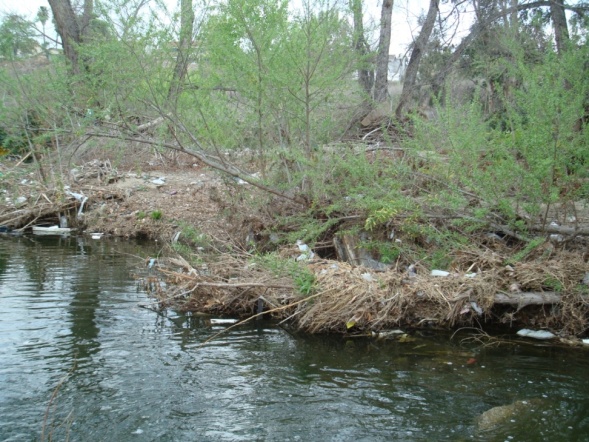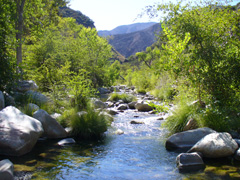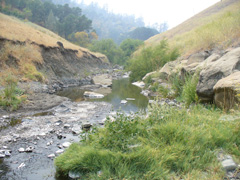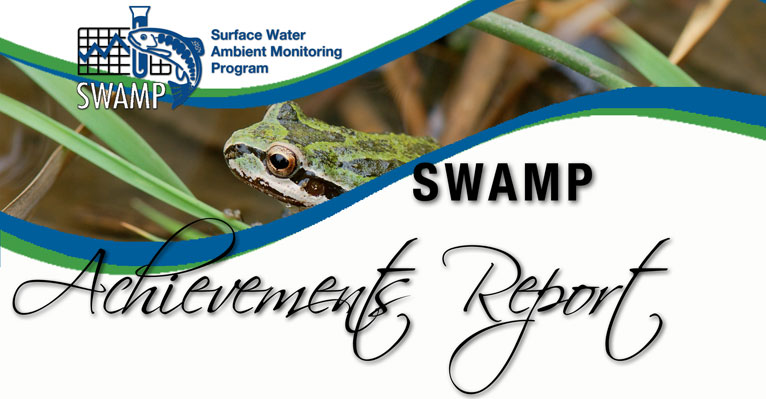SWAMP Achievements Report - Management Decisions
SWAMP Achevements Quick Links
Data are routinely used by the State Water Resources Control Board and the nine Regional Water Quality Control Boards to inform assessment reports, to make enforcement decisions, to develop permits and programs, and to make Clean Water Act 303(d)listing and 305(b) reporting decisions.
Years
2015
Statewide Efforts
- Developing Nutrient Objectives Policy using SWAMP’s Wadeable Streams Bioassessment Data – The State Water Board is developing nutrient objectives based on the Nutrient Numeric Endpoint (NNE) approach. This approach involves ecological response indicators (e.g. algal abundance and community metrics, dissolved oxygen) that have numeric endpoints linked to beneficial use protection. Models link the response indicator endpoints to numeric nutrient targets. SWAMP’s bioassessment program has collected data for ecological response indicators such as benthic macroinvertebrates, soft-bodied algae and diatoms, stream physical habitat, and basic water chemistry at over 1,000 wadeable stream reaches (reference and ambient). These data are being analyzed to inform the development of ecological response indicator thresholds for the Nutrient Policy.
Regional Efforts
- 2012 Integrated Report Driven by SWAMP Data (North Coast, Lahontan, and Colorado River Regional Boards) – The 2012 California Integrated Report is required by Section 303(d)(1) of the Clean Water Act. The North Coast, Lahontan, and Colorado River Regional Boards’ proposed 2012 California Integrated Report was approved by the State Water Resources Control Board in April 2015 and later approved by USEPA in July 2015. The data used to develop the 2012 Integrated Report was predominately comprised of the SWAMP data and data submitted by stakeholders. SWAMP data provides the bulk of water quality data evaluated to determine the health of surface waters throughout California for further Regional and/or State Board actions.
For the Integrated Report, data is evaluated by a water body-pollutant combination, referred to as a line of evidence (LOE). In the 2012 Listing cycle, the North Coast produced over 3,900 SWAMP LOEs out of approximately 4,900 LOEs. The Lahontan Region had over 1,500 SWAMP LOEs out of 1,700 LOEs, and the Colorado River Region had over 1,700 SWAMP LOEs out of approximately 1,740 LOEs. The SWAMP LOEs for these three regions comprised approximately 80-99% of all LOEs evaluated for the 2012 Listing cycle. The updated 303(d) List of impaired waters is generated out of the Integrated Report. Through this process, SWAMP data is used to determine the health of surface waters throughout our State for further Water Board actions. - Reissuance of Municipal Regional Stormwater NPDES Permit (MRP) for the San Francisco Bay Region – Regional SWAMP staff worked with Water Board permit writers to update the monitoring requirements within Bay Area creeks, streams, and rivers. The monitoring requirements are based on SWAMP comparability, which includes SWAMP quality assurance as well as the use of SWAMP field sampling methods such as the Bioassessment SOP. Permittees will sample for biological condition of benthic macroinvertebrates and algae, nutrients, chlorine, pathogens, and pesticides, as well as water and sediment toxicity, in urban receiving waters. A 2007 regional SWAMP report which documented trash problems in urban streams laid the groundwork for initial trash requirements in the previous permit, and led to continued requirements to reduce trash loads in the current permit.
2014
Regional Efforts
- Removal of Two Water Bodies from the 303(d) List (San Francisco Bay Region) – San Francisco Bay SWAMP staff collected data in the Napa River and Sonoma Creek mainstem and tributaries to help determine if these water bodies were still impaired by nutrients causing eutrophic conditions. SWAMP field crews relied on the SWAMP bioassessment SOP to produce eight measures (lines of evidence) of nutrients and eutrophic conditions. Two direct measures of algae biomass resulting from the SWAMP algae SOP are percent macroalgae cover and benthic algae biomass (measured using benthic chlorophyll-a). SWAMP staff also collected continuous monitoring data for pH and dissolved oxygen parameters using water quality sondes to evaluate if current algae levels were altering parameters that affect fish and wildlife. These two years of SWAMP-collected data were combined with previously-collected data to inform a long-term watershed analysis. The results of the analysis demonstrated the two water bodies were no longer impaired by nutrients causing eutrophic conditions, which led to a Resolution by the Regional Water Board in February 2014 to de-list the non-tidal (freshwater) portion of these streams. This Resolution will be evaluated by the State Water Board and EPA before it is final.
- Adopted Alternative Approach Total Maximum Daily Load for Phosphorous in the Loma Alta Slough (San Diego Region) – On June 26, 2014, the San Diego Water Board adopted Resolution No. R9-2014-0020 - Resolution of Commitment to an Alternative Process for Achieving Water Quality Objectives for Biostimulatory Substances in Loma Alta Slough. This action sets forth the path to eliminate excessive algal growth in Loma Alta Slough in Oceanside by using an existing regional stormwater permit designed to provide safe, cleaner water for the region. Utilizing an alternative Total Maximum Daily Load (TMDL) approach was considered innovative for the San Diego Water Board, and provides for a faster and more cost-effective remediation of the impairment. SWAMP data was utilized in the decision making process for the TMDL alternative, as San Diego Water Board staff reviewed available data for the Loma Alta watershed, which included SWAMP chemistry and stream bioassessment sampling. This data assisted in determining the condition of the watershed and evaluating more recent research on nutrient loading into Loma Alta Slough.
- Water Quality Certification Monitoring Requirements for State Route 76 (San Diego Region) – The San Diego Water Board is responsible for issuing Clean Water Act Section 401 water quality certifications associated with dredge and fill projects within waters of the United States. R9-2013-0035 was issued by the San Diego Water Board for fill associated with the State Route 76 South Mission Road to Interstate 15 project, a major transportation infrastructure improvement project in the San Diego Region with impacts to 5.5 acres of waters consisting of streambeds and associated wetlands. San Diego Water Board SWAMP and Monitoring Assessment & Research Unit (MARU) staff assisted Section 401 water quality certification permitting staff with the procurement and evaluation of SWAMP stream bioassessment data from sites in proximity to the proposed project and impact mitigation sites. Bioassessment data from these sites were utilized by permitting staff to evaluate the existing condition of waters in relation to the proposed project and mitigation sites. The resultant 401 water quality certification requires bioassessment be conducted at project sites to determine the impacts associated with the project, and at mitigation sites to determine mitigation success within the context of the project’s impacts. Bioassessment sampling is required to be conducted in accordance with SWAMP's standard operating procedures.
2013
Regional Efforts
- Practical Vision: Healthy Waters, Healthy People (San Diego Region) – In November 2013, the San Diego Water Board adopted a resolution in support of a new planning tool to focus the San Diego Water Board’s limited resources onto the region’s highest priorities for the next seven years. The Practical Vision sets a plan to achieve healthy waters through collaboration, reliance on the latest science, prioritization of issues and actions based on environmental outcomes, and prudent use of the San Diego Water Board’s authorities in service to the people of California. In order to implement the Practical Vision, conditions of healthy and degraded waters need to be characterized through monitoring and assessment. Consequently, one chapter is dedicated to monitoring and assessment and monitoring and assessment also plays a crucial role in the other four chapters of the Practical Vision.
2012
Statewide Efforts
- Biological Objectives – SWAMP bioassessment data are being used to develop biological objectives for the perennial streams of California. Biological objectives will help improve water quality in our streams and rivers by providing the narrative or numeric benchmarks that describe conditions necessary to protect aquatic life beneficial uses. In 2012 significant progress was made towards developing a scoring tool for evaluating biological condition and guidance for determining the causes of biological impairment.
Regional Efforts
- NPDES Permit (San Francisco Bay Region) – Data from SWAMP monitoring in the Suisun Bay supported the development of the Central Contra Costa Sanitary District wastewater treatment plant permit.
- CalDUCS Transfer (Central Coast Region) – The transfer of two data management tasks, data delivery and verification, to the Regional Data Center at Moss Landing Marine Laboratories.
- Adopted Resolution on New Monitoring and Assessment Framework (San Diego Region) – At the December 2012 Board meeting, the San Diego Water Board adopted a resolution in support of the new Monitoring and Assessment Framework for the San Diego Region. The new Monitoring and Assessment Framework follows the 2010 SWAMP strategy and outlines a systematic, question-driven, water body-oriented approach to monitoring and assessment. In the past, monitoring required by the San Diego Water Board has focused on discharges and whether discharges are in compliance with regulatory requirements. The most fundamental shortcoming of such a discharge-oriented approach to monitoring and assessment is that important basic information about conditions in water bodies is not produced. The new approach is intended to produce important basic information on conditions in water bodies needed to protect and restore beneficial uses of waters in the San Diego Region.
- Trash Monitoring Data in Southern California Used to Support Ban on Plastic Bags in the City of Los Angeles (Los Angeles, Santa Ana, and San Diego Regions) – Trash monitoring data had an influential role in the Los Angeles City Council’s decision to ban plastic bags in the City of Los Angeles. On May 23, 2012, the Los Angeles City Council voted to phase out single-use plastic bags over a time period of 16 months. The monitoring data used in the decision were collected under a southern California regional monitoring program conducted by the Stormwater Monitoring Coalition (SMC), which is partly funded by the SWAMP programs of the Santa Ana, Los Angeles, and San Diego Regional Water Quality Control Boards. This regional trash assessment is one of the first probabilistic surveys of its type in the nation, and provides the first estimates about the true extent of trash in coastal watersheds in the region. The results from the trash assessment indicated that plastic bags were the most prevalent trash item in southern California’s streams, representing nearly 20% of all items found during the survey.

2011

- Central Coast Agriculture Order (Central Coast Region) – The Central Coast Agriculture Order is a ground-breaking order. Among other requirements, this order defines high risk growers based on crop type, acreage, location relative to impaired waters, and pesticide use. This order also requires individual monitoring by those growers, and requires groundwater monitoring for nitrate concentrations.
- In the Central Coast Region, CCAMP/SWAMP data was used, in combination with storm water permit data and agricultural cooperative monitoring program data, to evaluate the impact of storm water and dry season discharge into the Salinas River and the Tembladero Slough systems. This analysis supported the monitoring requirements in the Monitoring and Reporting Program for the City of Salinas storm water permit. CCAMP data informed at least four other NPDES permit renewals and a proposal to conduct a Use Attainability Analysis for San Luis Obispo Creek. It also helped inform the Region 3 update on the Department of Water Resources Water Plan, as well as an EPA Measure W report on Chorro Creek. It was used to investigate possible illicit discharges by mushroom farms and fertilizer/pesticide distributors prior to issuance of a Notice of Violation. CCAMP data was used extensively in development the Santa Maria area nutrient and fecal indicator TMDLs, the Los Berros Creek nitrate TMDL, the lower Salinas River nutrient TMDL, and the San Antonio Creek chlorpyrifos TMDL. It was also used in the development of two reports to develop a Hydromodification Control Methodology for the Region, including a watershed characterization and a linkage analysis to receiving water conditions, and was used to confirm basic conditions in receiving waters affected by urbanization.
- The San Diego Water Board SWAMP Strategy (San Diego Region) – The San Diego Water Board identified effective monitoring and assessment as a top strategic priority following a 16-month office-wide Executive Leadership Development Program led by the University of California Davis Extension Program. The SWAMP strategy and SWAMP data will be the foundation for developing and implementing a new framework for monitoring and assessment in the San Diego region. The framework coordinates the monitoring work done by the San Diego Water Board, regulated parties, and other stakeholders in order to better assess the condition of receiving waters, promotes strong environmental outcomes, and drives decision making.
- Biological Objectives – SWAMP bioassessment data are being used to develop biological objectives for the perennial streams of California. Biological objectives will help improve water quality in our streams and rivers by providing the narrative or numeric benchmarks that describe conditions necessary to protect aquatic life beneficial uses.
2010

- Biological Objective Development (SWAMP)
Biological Objectives are being developed for California streams to establish thresholds for biological condition that will be implemented in SWAMP regulatory programs. Perennial Streams Assessment (PSA) and Reference Condition Management Program (RCMP) data are being used to support this effort. - Ammonia & diatom correlation study effects Sacramento Regional Wastewater Treatment Plant NPEDES discharge permit (San Francisco Bay Region)
Results from a San Francisco Bay region SWAMP study on the relationship between ammonium and spring diatom blooms in Suisun Bay played a significant role in decisions made by the Central Valley Regional Board on discharge limits in the renewal of the Sacramento Regional Wastewater Treatment Plant NPDES permit. - Urban and Agricultural Sources of Pyrethroid Insecticides to the Sacramento-San Joaquin Delta (Central Valley Region)
Findings in the Urban and Agricultural Sources of Pyrethroid Insecticides to the Sacramento-San Joaquin Delta report support inclusion of requirements for whole effluent toxicity testing using Hyalella azteca as waste discharge requirements for the Sacramento Regional County Sanitation District discharge permit. - 303d listings based on SWAMP Data (Central Coast Region & Bioaccumulation Workgroup)
The 2010 Integrated Report [Clean Water Act Sections 303(d) and 305(b)] contained over 11,000 lines of evidence (LOE) for the listing and delisting of waterbodies that were generated from SWAMP data. The Central Coast Regional Water Board SWAMP program (CCAMP) developed software to analyze all Central Coast SWAMP data electronically, and develop “Lines of Evidence” for listing and delisting of impaired waters in the Central Coast Region, 2008 Integrated Report. This approach allowed the Central Coast Region to produce over 10,000 LOEs for the 2008-2010 Integrated Report, with much of it originating from SWAMP data. < br /> In the Central Coast, a number of water bodies were listed as impaired for aquatic life uses by nitrate in the 2008-2010 Integrated Report. The listings were based on exceedance of numeric action levels for nitrate with supporting evidence of eutrophication. The action level was developed by staff using nutrient information for the Central Coast Region, currently in the SWAMP database, and through application of the State's Nutrient Numeric Endpoint technical approach. - SWAMP Bioassessment Data Provided Critical Information in the Adoption of the New Riverside Municipal Stormwater Permit (San Diego Region)
Previous versions of the Municipal Separate Storm Sewer System (MS4) Permit for southwest Riverside County were typically less stringent than concurrent MS4 permits for portions of San Diego and Orange Counties under the purview of the San Diego Water Board. This, in part, contributed to degradation of water quality as rapid development occurred in southwestern Riverside County. In preparation for the permit reissuance, a review of SWAMP benthic macroinvertebrate (BMI) data clearly demonstrated that the ecological health of urban sites in southwestern Riverside County was consistently poor and had declined over the past several years, while the ecological health of minimally impacted reference sites was consistently good, with some improvement over time. The degradation of water quality identified by SWAMP bioassessment data was sufficiently troubling to warrant permit changes. The San Diego Water Board adopted a new MS4 Permit for southwestern Riverside County on November 10, 2010. The new permit is comparable to the Orange County Municipal Stormwater Permit that was adopted in 2009. These two municipal stormwater permits now include numeric action levels, detailed and extensive monitoring requirements, as well as the inclusion of low impact development mandates and the obligation to develop hydro-modification management plans. The SWAMP data graphically demonstrated declining water quality and a direct assessment of Beneficial Uses in the urban environment; which were both critical considerations during development and adoption of a more stringent MS4 permit. - Fish Consumption Advisories
Since the release of the Statewide Lakes 2-year report on the bioaccumulation of contaminants in sport fish in June 2010, several Regional Water Quality Control Boards (RWQCB) have followed-up with the initiation of additional sampling in problem areas, collaboration with County Health Officials to post warnings at lakes with high contaminant concentrations in fish, and responding to media interest. Follow-up sampling was initiated in the San Francisco Bay, Central Coast and Santa Ana Regions at locations with significantly elevated contaminant tissue levels. Working in conjunction with the Office of Environmental Health Hazard Assessment (OEHHA), the additional data collected will be used to develop new fish consumption advisories for the public at select lakes. - Data Screening Software
The State adopted the Central Coast Regional Water Board's software to comprehensively screen all the States SWAMP data for the 2012 303(d) List, and evaluated all data sources for all applicable beneficial uses. - Toxicity Summary
Supported recommendations in the draft Toxicity Policy - Stormwater Permitting and Conditional Waivers
Recommended using toxicity testing in stormwater permitting and conditional waivers of waste discharge requirements for agriculture.
2009
Examples of specific management decisions in 2009 and supported by SWAMP monitoring and assessment information:
- The 2010 Integrated Report for the federal Clean Water Act Sections 303(d) and 305(b) contained a total of 22,251 lines of evidence for the listing and delisting of waterbodies - 11,743 lines of evidence were contributed from SWAMP data.
- The placement of 26 waterbodies on the Clean Water Act Section 303(d) list for trash in the San Francisco Bay Region was possible by using a trash assessment method developed by SWAMP; additionally, new trash requirements were incorporated into the recently adopted municipal regional stormwater permit.
- The adoption of a municipal separate storm sewer systems (MS4s) regional permit was adopted that required all applicable monitoring to be SWAMP comparable for Alameda, Contra Costa, San Mateo, and Santa Clara Counties and the cities of Fairfield, Suisun City, and Vallejo.
- The San Diego Regional Water Board adopted the first numeric action levels for a stormwater permit in California. The scientific basis of the numeric action levels was partially based on data collected under the SWAMP.
- The revision and/or development of 18 fish consumption advisories and safe eating guidelines by the Office of Health Hazard Assessment were made possible by new information that included data from SWAMP.
- The Central Coast Regional Water Board used SWAMP data and the State Nutrient Numeric Endpoint technical approach to develop a numeric criterion for nitrate for use in assessing water bodies for aquatic life impairment.
- The Central Coast Regional Water Board developed software to comprehensively screen data for the 2010 303(d) List, and evaluated all data sources for all applicable beneficial uses.
- The Central Coast Regional Water Board consolidated SWAMP and agricultural regulatory program data and conducted a comprehensive analysis for support of the new Order for Irrigated Agriculture. The assessment includes an updated website with map and chart displays of site status and change.
Questions and Comments
- Please direct inquiries to the State Water Board, Surface Water Ambient Monitoring Program (SWAMP).
- State and Regional Board contacts listing: https://www.waterboards.ca.gov/water_issues/programs/swamp/swamp_contacts.html



